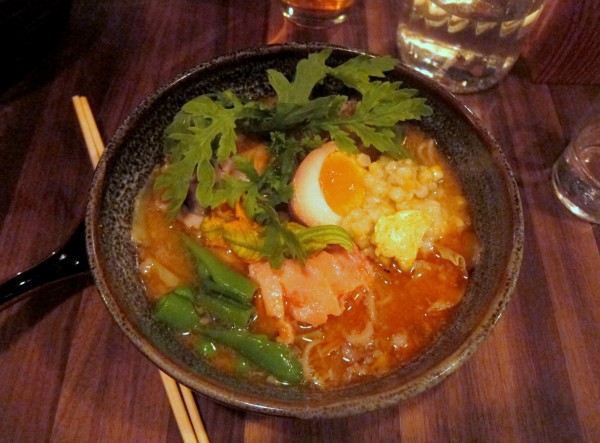 Hokkaido butter corn miso ramen with smoked king salmon, pork belly, soy-marinated egg, snap peas, chrysanthemum greens, and shiitake. ($16) Okay so, The Ramen Shop is not a place I would go alone. I think eating there alone would be particularly wonderful because ramen is the type of food to be eaten alone, and although the lighting might be too low for reading, it’s hard to read while slurping noodles anyway. BUT, the wait is just too horrible. This place has been hyped up since its opening in January, and it stays hyped. No sensical lone diner should wait an hour for a bowl of ramen. It’s good ramen, though. I didn’t expect too much, and I was satisfied. Continue reading one shot: Salmon ramen at The Ramen Shop
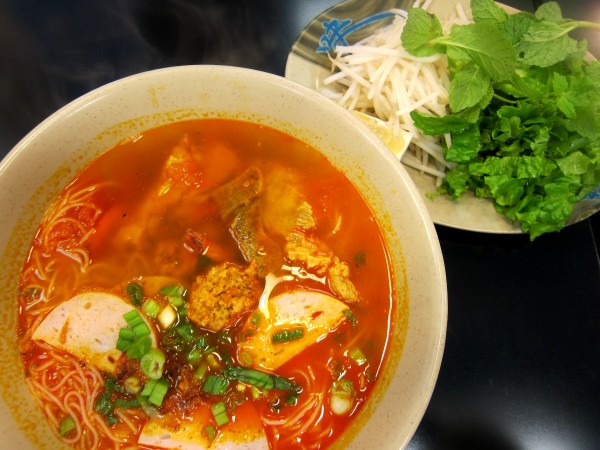 Good ol’ tomato and crab noodle soup from Southern Vietnam: bún riêu (pronounced |boon rhee-oo|). The broth looks alarmingly spicy but this soup is actually never spicy. The orange red color comes from tomato and annatto seeds, and if you’re lucky, crab roe (if fresh crabs are used for the soup). The sweetness of the broth comes from freshwater paddy crabs, where the whole crab (meat and shell) is ground to a paste and strained for the juice. It’s a delicate, distinctive sweetness that can’t be reproduced with dashi no moto, meat bones or mushroom. To deepen the flavor, the cook adds some mắm ruốc, fermented krill paste, to the broth. Traditionally, bun rieu has crab meat and tofu for the protein part, but bun rieu at Ba Le Sandwich is ladened with cha lua, pork and shrimp. Continue reading one shot: Bun Rieu at Ba Le Sandwich
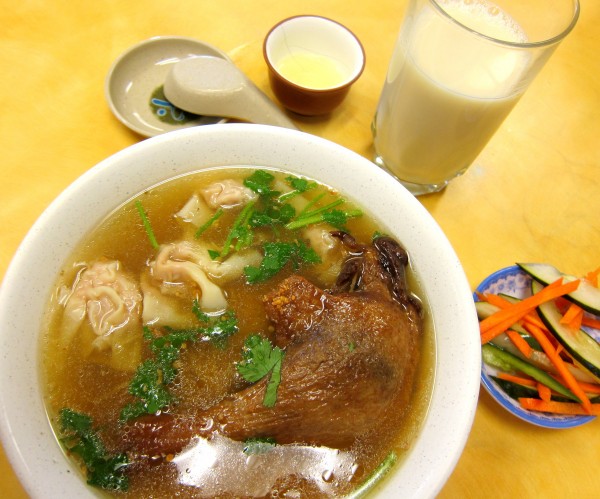 Like many small businesses in the so-called “Little Saigon”s throughout the states, Hai Ky Mi Gia is operated by Chinese immigrants. Originally, Hai Ky Mi Gia is a popular noodle soup joint in District 5, Saigon – the Chinatown of Saigon – before 1975, and it remains popular today. When Saigon fell, the Chinese immigrants in Vietnam left the country with the Vietnamese and became associated with Vietnamese political refugees in foreign lands such as America. These Chinese Vietnamese immigrants continue speaking both languages, opening businesses under the established names(*) in Saigon and catering to the homesick Chinese Vietnamese and Vietnamese alike. Whether this Hai Ky Mi Gia is in any way related to the Hai Ky Mi Gia in District 5 or other Hai Ky Mi Gia’s scattering across the US, its patronage doesn’t seem to care either way. To the Chinese Vietnamese and Vietnamese immigrants, it’s a name they’re familiar with, so they feel at home. To the rest of the patronage… well, I can’t speak from their point of view, but I guess the low price and the popularity raved by Yelp, InsideScoop SF, Continue reading Hai Ky Mi Gia – more noodle soups
 Kinoko harusame (~$8) – potato starch glass noodle soup with mushroom (shimeji, eryngii, enoki, hiratake (oyster mushroom), portobello mushroom and shiitake. Japanese glass noodle (harusame 春雨) is different from Vietnamese glass noodle: it’s made from potato starch (instead of mung bean starch or canna starch), it’s much thicker (like a spaghetti, whereas Vietnamese glass noodle is like a capellini), and it has a softer chew. With that vegan broth sweetened by mushroom, it was comforting. Continue reading One bite: Harusame soup at Cha-Ya
 It’s summer. Time for cold noodle. Refrigerated, ice-cold noodle. And all it takes is 10 minutes (that includes water-boiling time). Traditionally, the Koreans sweeten mul naeng myeon (물 냉면, “water cold noodle”) with sliced Asian pear and julienned cucumber. Asian pears are not yet in season (I don’t really know when its season is, but the tiny ones at Berkeley Bowl look too sad to slice), and when I want to cook my naeng myeon, like always, I never have what the recipe calls for, even if it’s just cucumber. So I did what everyone would. I ignored the recipe. Continue reading Ten-minute noodle and nectarine
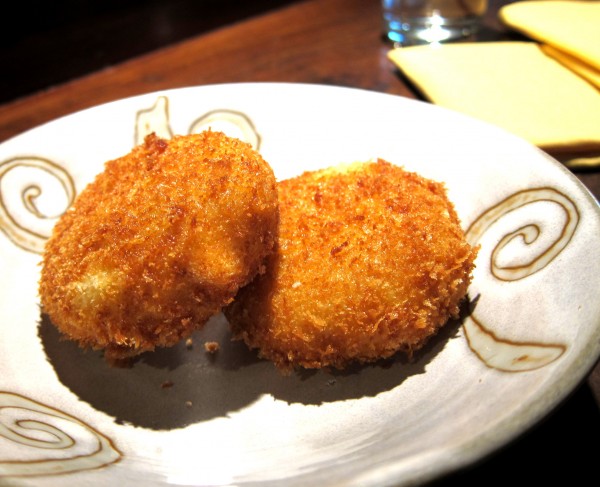 After a 5-course afternoon tea, the three of us felt our stomachs’ calling. The wind blew chilly moisture from the sea. A hearty dinner of noodle in hot broth would hit the spot, one that was saturated with oolong. Quite appropriately, we walked into O Chamé, meaning “eye of tea”(*) literally and “playful little one” colloquially. It’s Mother’s Day, no reservation, we couldn’t be any luckier that the guy found us three seats at the end of the bar. Of course, who would skip the appetizers. And of course, we couldn’t decide on just one appetizer, so we ordered three. The potato and snow crab croquette ($8.50), buttery but mild, tastes ten times better after a dip in the plumier-than-usual-and-not-too-sour tonkatsu sauce. Usually I don’t dip my stuff, but the sauce is a must here. The grilled, caramelized eel ($10.50), Kristen’s choice, is great. Little Mom loves eel, and she would love this. Happy Mother’s Day, Mom! 🙂 A bite into the crisp endive releases a burst of sharp, almost minty air to balance the eel’s fatty sweetness. Continue reading In the Eye of Tea
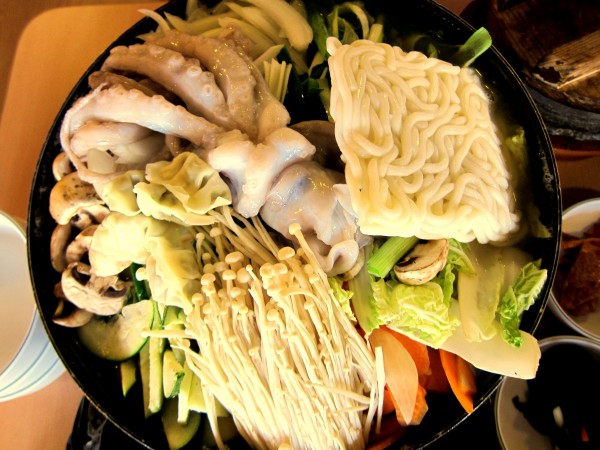 Lately I think I’ve reached a wall in terms of Korean food. To be precise, the Korean food that I can get my hands on, i.e., in the Bay and in Houston. Every Korean restaurant here, in strikingly similar manner to Vietnamese restaurants, has the same menu as every other Korean restaurant. The menu may contain a hundred things, but it boils down to maybe ten, with tiny variations. To be blunt, I’m bragging that I can name practically every dish on a Korean menu in the States. The novelty is gone. Little knowledge is left to obtain. But just as I don’t stop going to Vietnamese eateries altogether, I still like to share a big Korean meal with Mom and Dad. A bubbling jeongol, rice and banchan always give the familiarity that a Western meal cannot. That said, there are a few things that I’m still not used to, such as the scissors. The lady was cutting up the crabs and octopus with big black scissors. I admit their convenience, but I get the weird feeling that she is cutting flowers. Why? I don’t know. Anyway, I didn’t eat […]
Continue reading I can’t think of a title for Tofu Village
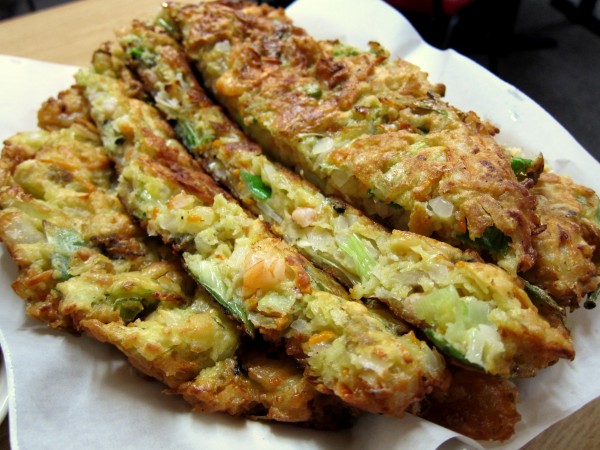 Unpredictability #1: “Are you opened today?” Before you set your GPS to Myung Dong in Houston, make sure you call and ask that question in the clearest, simplest way possible. Aaron tried different versions, most were a bit too elaborately polite with a perfect American accent, and only succeeded in confusing the poor old man. I tried it once and got the answer “Yes, open.” We hopped en route. (If you don’t call, there’s a slim chance that your schedule will coincide with the owner couple’s schedule, which depends on the lady’s health, and she’s the only chef. That slim chance didn’t happen for me the first time I set out for Myung Dong.) The limited English conversation is nothing uncommon at Korean and Vietnamese mom-and-pop diners, but I have to mention it because it’s one of those things that make me classify Myung Dong as more “authentic” than the other Korean restaurants in Houston. The second thing is that its name doesn’t contain “Seoul” or “Korean”, they go more local: Myungdong (명동) is a part of Seoul (in Vietnam, its equivalent would be a phường). The third thing is that […]
Continue reading The unpredictable Myung Dong
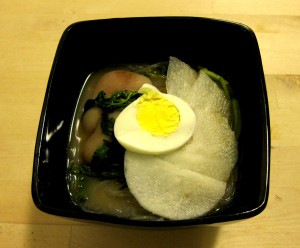 Sometimes my craziness surprises myself. I woke up one morning, reflecting that the week’s been warm, and decided to make mul naengmyeon (물 냉면). Weeks earlier, I bought the buckwheat noodles but never had the time to cook, or the mood. Now I still don’t have time to cook, but today is the day. I remember the main ingredients of a true Korean naengmyeon, but just to make sure that I don’t have them, I look at Maangchi’s recipe anyway. Beef bones? No. Mushroom? No. Dried anchovies? No. Kelp? No. Yeolmu kimchi juice? Hah. In my dreams. I don’t even have cucumber. Am I going to the store? Of course not. The wind might blow away my cooking mood, which is already rare as it is. Besides, I have a blind confidence that what I do have will make a fine bowl. The deaf ain’t scared by gun fires, they (we Vietnamese) say. Naengmyeon has three fundamental components: the broth, the buckwheat noodle, and the toppings. The broth needs to be clear and slender. To get the sweetness, I substitute beef bones by pig trotters. They have plenty of bones, and unfortunately […]
Continue reading Korean chilled noodle soup with a few Vietnamese twists
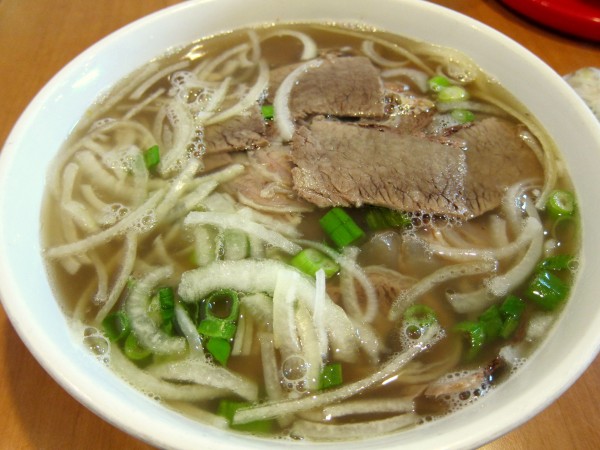 Every time I ride the bus on Telegraph, Kang Nam Pho stands out to me like a supernova. (There are these “sorta” cosmologically important exploded stars that have been on my mind for quite some time now, which is an excuse for the sparse blogging of late.) I’ve seen Chinese-owned pho places, but they never have a Chinese name. Pin Toh on Shattuck, which used to be Phở Hòa, has pho cooked by Chinese chefs, but it’s a Thai diner (talk about incognito). In my American pho encounters, Kang Nam Pho is the first instance of a Korean-owned Vietnamese diner with a Korean name. They even put the whole “Phở” with accents on their white-on-red sign, next to “강남 윌남국수” (Kang Nam Wilnam guksu, i.e., Kang Nam Vietnamese Noodle). I like this place already. Their menu is also all in Vietnamese, again, with complete accents albeit some misspellings; there is English description under each name and very little Korean. I vaguely remember bibimbap and bulgogi at some bottom corner of a page, but Kang Nam has things that even a common pho joint wouldn’t always have, such […]
Continue reading The Koreans make good pho
|
|
Blogs we read
|












